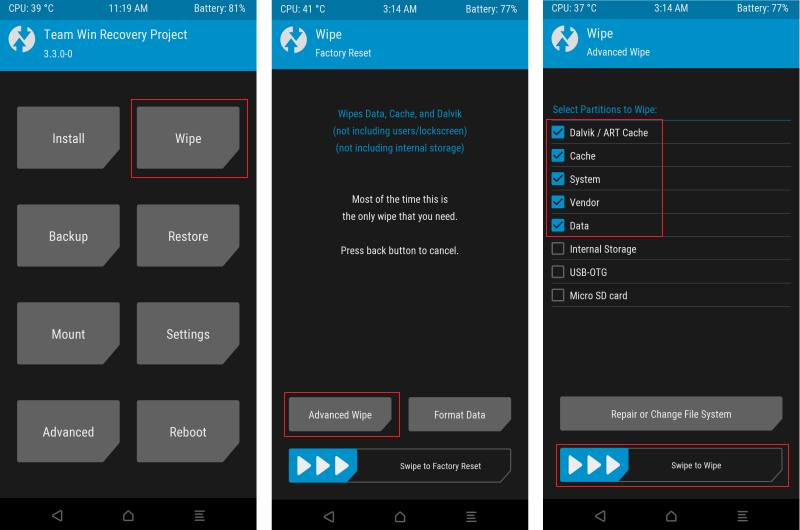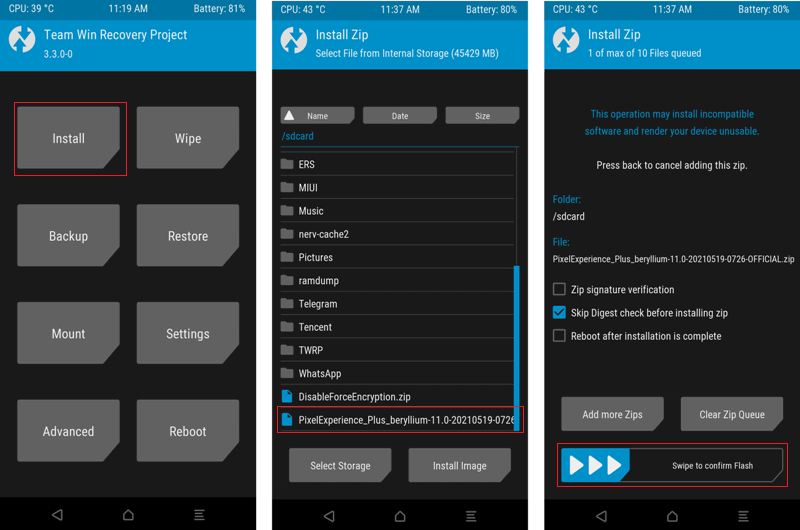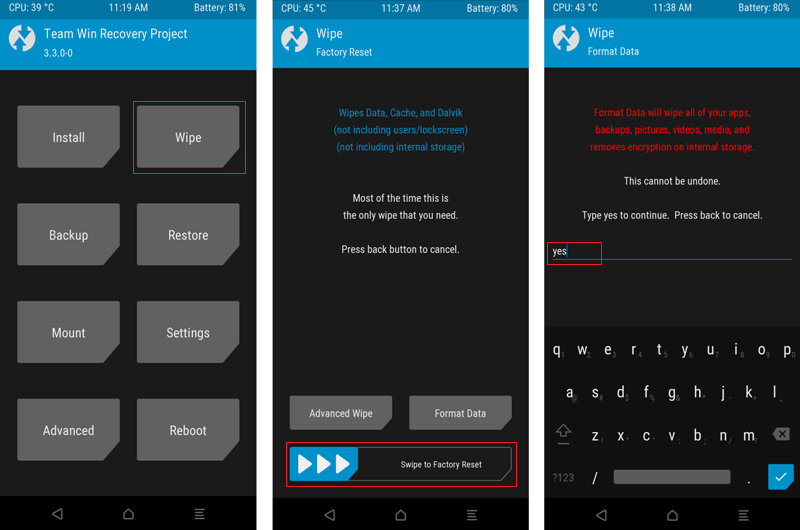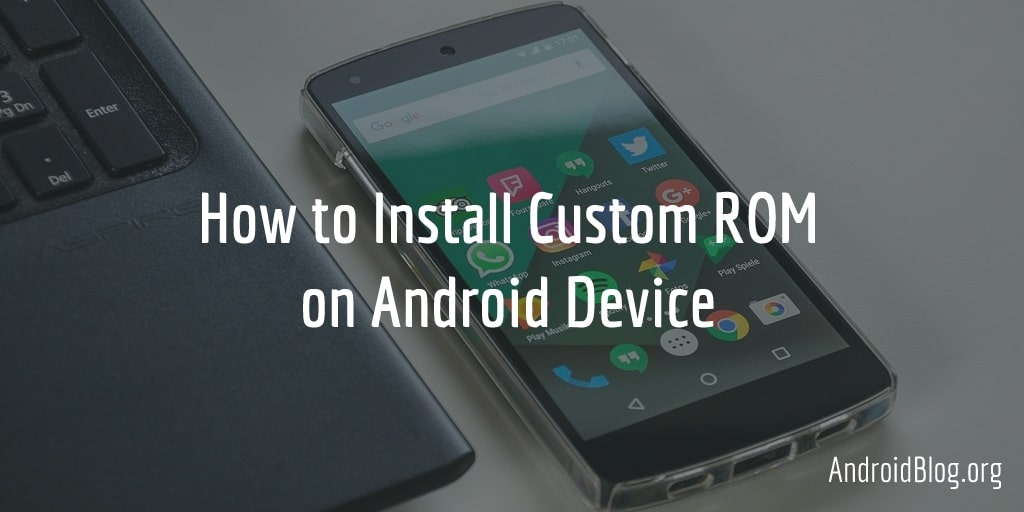If you’re reading this post that means you have decided to install a custom ROM on your Android device.
Congratulations!
Believe me, you’re forever going to be thankful you took this step. Not everybody does.
While this may sound dramatic, I do mean it. Because you’re missing out on so much by sticking to the normal way of using your Android.
The normal way here means what most people do. They buy the device and stick to the settings and the operating system that the manufacturer provides. And then they trash it once it seems to be not usable anymore. (But is it? We will find out soon)
Although it might be fine to an extent, you’re not tapping the full potential of the device and the incredible Android community that is happy to support it.
If you’re an Android enthusiast, there are several ways to enhance your experience with the device, such as:
- Enable Developer Options
- Root your Android
- Install custom ROM on Android
In this article, we’re going to focus on the third point, i.e., how to install custom ROMs on your Android device.
Before that, a quick recap on what custom ROMs are and why they are so cool.
Custom ROMs are aftermarket versions of the Android operating system that are developed by Android enthusiasts by forking the open-source Android code.
- They allow you to experience the latest Android versions on devices that don’t receive updates from the manufacturer anymore.
- Almost all custom ROMs are based on AOSP and retain the look and feel of pure Android without stupid skins.
- Most custom ROMs offer a wide array of features, tweaks and customizations to enhance your Android experience.
- Unlike stock ROMs, they are not loaded with bloatware.
- Custom ROMs allow you more access to the hardware and performance aspects of your device that most manufacturers put a restriction on.
- Overall, they breathe fresh life into your old devices.
Here’s an article on everything you need to know as a beginner about custom ROMs and their pros and cons.
A few very important things to keep in mind:
- This is a generic guide, which means that these are the steps that apply to most Android devices. It is advisable to cross-check them with the XDA thread of the ROM for your device.
- I would advise reading this tutorial on your computer so that the steps, commands and screenshots are easy to follow.
- If you’re in doubt at any point, stop. Check for other guides online to see if they can answer your queries before proceeding. Else you can always put in a comment here, although it means you have to wait for my response which can take some time.
Table of Contents
Prerequisites
Before you start with the process, make sure you have the prerequisites in place.
- Your Android device: Fully charge your device.
- PC/Laptop: It should be in perfect working condition. Sudden freezes and reboots can get you into a problem.
- USB data cable: Preferably the original cable that came with your device.
- Android SDK Platform-Tools: Download the latest files to your PC/Laptop.
- Custom recovery: Download the latest TWRP recovery for your device on your laptop.
- Custom ROM: Download a custom ROM compatible with your device on your laptop. Refer to our list of the best custom ROMs for Android.
- Gapps (optional): If you want to use Google services, download the latest Gapps compatible with your device architecture and custom ROM Android version from here on your laptop.
- Magisk (optional): If you want root access, download the latest Magisk from here on your laptop.
- Patience: This is a long (and somewhat scary) process for beginners. You have to diligently follow the steps if you love your device.
Let’s dive into the process.
How to Install Custom ROM
The process of flashing a custom ROM on Android involves multiple steps. It starts with preparing your PC and Android device so that all necessary files, drivers and settings are in place. Thereafter, the actual process of modifying your device starts. I will cover the steps one by one and try to be as descriptive as possible while staying within the scope of this tutorial.
Backup your device
Before you start with the process of flashing a custom ROM on your Android smartphone, it is important to backup all important data such as photos, videos, application settings, etc. This is because by the time you finish with the steps, all your data will be wiped off and recovering them will not be straightforward.
There are several ways of doing this. I would recommend connecting your device to your PC and transferring all the files you want to retain. For app settings, I would recommend syncing them to your Google account if you wish to have them retrieved automatically once you boot into your new ROM. However, this is not recommended and I would always suggest clean installing the apps from Google Play and setting them up afresh.
Install smartphone drivers on PC
To make sure the PC recognises your smartphone, you have to install the necessary drivers. This usually happens automatically when you connect your smartphone to the computer via a USB cable. However, if it doesn’t, you will need to manually download the drivers for your model from the manufacturer’s website and install them on the PC.
Install Android SDK Platform-Tools
This is an important step. Download and install the Android SDK Platform-Tools for your PC. This will provide the necessary ADB and Fastboot binaries and allow your PC to recognise your device in ADB and Fastboot modes.
Enable Developer Options, USB debugging and OEM unlocking
Step 1: To enable Developer options on your Android device, navigate to the path below.
Settings > About Phone > Build Number
Step 2: Next, tap the Build Number 7 times. You will receive a notification that says “You are now a developer!”.
Step 3: After this, you need to enable USB debugging. This allows your device to communicate with the Android SDK over a USB data cable. To achieve this, navigate to the path below.
Settings > System > Advanced > Developer Options
Look for “USB debugging” and turn on the toggle.
Step 4: In the same menu, turn on OEM unlocking.
Unlock bootloader
The time has come to get your hands dirty.
Step 1: Connect your Android device to the PC via USB cable.
Step 2: Open the folder where the Platform-Tools files are stored and open Command Prompt. This can be done with a Shift+Right click on an empty area and selecting ““Open command window here”. Alternatively, you can type “cmd” in the address bar and hit Enter. Command Prompt has now been launched.
Step 3: You need to make sure the Android SDK recognises the device. To do this, enter the command below.
adb devices
The result will be a “List of devices attached” along with a random device code. This means the connection is successful. If the device is not recognised, recheck all the previous steps. Also, make sure the USB cable is a working one.
Step 4: Now you need to boot your device into the bootloader (fastboot mode). To do this, type in the below command and press Enter.
adb reboot bootloader
Your device will now restart and boot into fastboot mode. On most devices, it will be a black screen with a green Android robot with some device information below.
Step 5: To confirm if your device is successfully communicating with Android SDK in fastboot mode, type in the below command.
fastboot devices
This will return the same device code that you got with the “adb devices” command sometime back.
Step 6: At this point, we will perform the actual bootloader unlocking. Execute the below command to unlock the bootloader.
fastboot flashing unlock
If this command doesn’t work, don’t worry. For older devices, you may try the command below.
fastboot oem unlock
If your device prompts you to confirm the process, use the volume up/down button to select “Yes” and the power button to confirm the selection. Note that this doesn’t apply to all devices.
The bootloader unlocking process will now start and should not last more than a minute.
Step 7: Once the bootloader is successfully unlocked, the device will reboot itself back into fastboot mode. Enter the below command on your PC to reboot into the operating system.
fastboot reboot
Hang on, your device will be reset to factory settings during the reboot so it may take a while. The boot up screen may show a warning that your device is unlocked and is not secure. No need to worry, just let it finish the process.
Do a quick setup on your device. You don’t need to add your Google account at this point if you want to flash a custom ROM as it will be erased again. However, if you just want to install a custom recovery, you can do a proper account setup.
You will not notice any difference on your device yet. Now that the bootloader is unlocked, you are ready to flash a custom recovery, root your device and install a custom ROM.
Install Custom Recovery
Now it’s time to install a custom recovery on your Android device. This will allow you to install any custom ROM later. Another advantage is that custom recovery is far more powerful and feature-rich than the stock one that comes preinstalled on your device.
For this tutorial, we will use TWRP recovery. TWRP stands for TeamWin Recovery Project. It is the most popular custom recovery and gets updated with features and bug fixes regularly.
However, you can use other custom recoveries as well, such as OrangeFox recovery, which is in fact based on TWRP. I will write a separate article dedicated to OrangeFox recovery later.
For most devices, TWRP recovery consists of just an image file (.iso). However, for some devices, you will get two files, an image file as well as a zip installer. The steps are a little different for the two types of TWRP installers, so you have to be very careful with the process.
To install TWRP recovery, follow these steps:
Step 1: Enable Developer options and USB debugging by following the steps we discussed before. We are doing this again because your device was factory reset at the end of the unlocking bootloader process.
Step 2: On your computer, rename the recovery image file to twrp.img and place it in the folder that contains the Platform-Tools files.
If your device’s TWRP has a zip installer as well, place it in the internal storage of your device.
Step 3: Connect your device to the computer via USB cable.
Step 4: Launch Command Prompt inside the folder again as you did before.
Step 5: Run the below command to reboot into the bootloader.
adb reboot bootloader
Your device will restart and boot again into fastboot mode.
Step 6: Execute the below command to make sure the device is communicating with the Android SDK over fastboot mode.
fastboot devices
If it returns the device code then we can proceed. Note that this is an optional step, but it’s good practice to follow.
Step 7: Run the below command to flash TWRP recovery on your device.
fastboot flash recovery twrp.img
Now, wait for the process to finish. If things go well, you will see a success message in your Command Prompt window.
Step 8: Lastly, execute the below command to reboot into the just installed TWRP recovery.
fastboot boot twrp.img
Your device will now restart and boot into TWRP recovery.
If your device’s TWRP installer is just an image file, the TWRP boot up will patch the OS on your device to prevent it from replacing TWRP with the stock recovery on the next boot up. This happens behind the scenes and you don’t have to do anything.
If your device’s TWRP consists of both an image and a zip installer, you have a few more steps to follow to make the TWRP installation permanent.
Step 9: Tap on Install in the TWRP menu.
Step 10: Select the ZIP file from the internal storage.
Step 11: Swipe the button at the bottom of the TWRP screen to flash the installer file.
The flashing process will not last more than a minute and will return a success message if everything goes well.
Well done! You have now successfully replaced the useless stock recovery on your device with a polished custom recovery.
You can now reboot to your current OS. To do so, go to the main menu of TWRP recovery, tap on Reboot and select System.
Install Custom ROM
So, you’re now in the final stages of installing a custom ROM on your Android. The good part is, if you have reached this far, the remaining steps are a cakewalk.
Step 1: Copy the custom ROM, Gapps (optional) and Magisk (optional) files to your device’s internal storage.
Step 2: Remove security settings such as pins, patterns and fingerprint locks that you have set up. Also, remove your Google account from Settings > Accounts.
Step 3: Next, you have to boot into recovery. This can be done in two ways:
If you’re connected to your computer via USB cable and USB debugging is enabled, run the following command in Command Prompt the same way we were doing before.
adb reboot recovery
Alternatively, you can press and hold Power+Volume Up button for a few seconds. The device will restart and you will need to release the buttons once you see the manufacturer logo at boot up.
For some devices, the combination will be Power+Volume Down. I would recommend a quick Google search to find out the combination for your device.
After this, the TWRP screen will show up.
If TWRP asks you to confirm whether to Keep System Read only, swipe across where it says Swipe to Allow Modifications. This is important since keeping the system read-only will prevent TWRP from making changes.
Step 4: Now we need to wipe the existing operating system and data from the device. To do this, tap on the Wipe option in the TWRP menu. On the next screen, tap on Advanced Wipe.
Select Dalvik / ART Cache, Cache, System and Data partitions. For some custom ROMs, you may have to select Vendor as well. Cross-check this with the ROM specific installation guide.
Then swipe across the screen where it says Swipe to Wipe. This operation will format the selected partitions and will take a few seconds to complete.
Wipe > Advanced Wipe > Dalvik / ART Cache, Cache, System, Data, Vendor (optional) > Swipe to Wipe

Step 5: At this step, we will flash the custom ROM. To do this, go back to the TWRP home menu and tap on Install. This will open your device’s internal storage file system where you have to select the file you want to install. Select the custom ROM ZIP. On the next screen, swipe across the screen where it says Swipe to confirm Flash.
Install > Select ROM package > Swipe to confirm Flash

The process for custom ROM installation will now begin. It will take some time to finish, until then don’t mess with the device.
Once the flashing is complete, you will see a success message on your screen.
Super stuff there! You just installed a brand new custom ROM on your dear Android device.
Important: Don’t reboot the device yet. If you want to install Gapps and/or Magisk, read the next two sections. Else jump to the last part.
Install Gapps for Google services (optional)
Although an optional step, you must flash the Google apps package aka Gapps if you want access to Google Play services for your apps. Installation follows the same process as flashing the custom ROM.
Assuming you have already copied the Gapps installer zip to your internal storage. Tap on Install on the TWRP home menu and select the Gapps package zip. Then swipe to confirm the flash on the next screen like you did before.
Install > Select Gapps package > Swipe to confirm Flash
The installation process will take a few seconds to complete after which you will see a success message.
Install Magisk for Root access (optional)
Lastly, if you want root access on your Android device, you have to install Magisk. It is not mandatory to flash it right away as you can do it any time later.
Anyway, I’m assuming you want to get access to your device’s root and have already copied the Magisk installer zip to the internal storage.
You can flash it just like you flashed Gapps. Tap on Install on the TWRP home screen, select the Magisk zip and swipe to confirm the flash.
Read our tutorial on rooting Android for further understanding.
Install > Select Magisk package > Swipe to confirm Flash
You will see a success message once the installation is completed.
Factory Reset and first boot up
Now that you have installed a custom ROM on your device, and probably Gapps and Magisk as well, it’s time to perform one final step.
You need to do a Factory Reset. To do this, tap on Wipe and swipe to confirm where it says Swipe to Factory Reset. You will get a prompt to reconfirm that you want to format the data. Type “yes” and tap Okay on the keypad.
Wipe > Swipe to Factory Reset

Note that this is not a mandatory step. However, I would recommend doing this as it completely cleans up your internal storage before the first boot up.
Once the Factory Reset is done, simply tap on Reboot.
Your device will now start booting into Android and you will be greeted by its bootanimation of the custom ROM.
From here on, you won’t need any guidance. Just perform the usual setup such as setting up your Google account, WiFi, etc. Note that this setup process depends on whether you have installed Gapps or not, so don’t be surprised if you directly land on the Android home screen without any initial setup.
That’s it, enjoy the custom ROM experience!
Now that you’ve reached the end of the tutorial, I really hope you’ve succeeded in what you started without any hiccups. I have tried to write this tutorial keeping in mind the absolute beginners. Yet, if there are things I can improve, I would be glad to hear about them.
Cheers!








Thanks for the tutorial. Does it work on a 10 year old old laptop?
Hi Joshua,
Assuming you mean whether you can run the ADB and Fastboot commands from an old laptop, the answer is yes, as long as it supports Platform-Tools and the smartphone drivers. Try the “fastboot devices” command to check if the connection is working. Let me know how it goes.
Very helpful guide you have got there and I finally have a custom rom 🙂
Happy to help.
See you said “hope you’ve succeeded in what you started without any hiccups”. What if we get stuck somewhere? Is there any post for that?
Good question, Aman.
Like I’ve mentioned, this is a generic guide to installing a custom ROM. However, it is important to understand that the steps may differ a little here and there depending on your device and the specific custom ROM that you’re installing.
Unfortunately, it’s not practically possible to have a guide to troubleshoot all the possible issues for each and every device and custom ROM, as there will be hundreds, if not thousands, of them.
So, if you get stuck somewhere, while you can absolutely ask here, it’ll probably help if you check the XDA thread for the particular ROM as well. Chances are that someone else has already reported the same issue and it has already been answered by the developer.
M
Having said that, may I know the device that you’re using and the custom ROM you want to install on it?
Hello Nilayan,
Thank you for the tutorial. I am trying to replace the ROM on Nokia G50 (chinese market version) with a global version. Now I got stuck at the “unlocking bootloader” step. I tried both commands:
./fastboot flashing unlock
./fastboot oem unlock
yet both return the same error:
FAILED (remote: ‘unknown command’)
fastboot: error: Command failed
Kindly help, please.
Thank you.
Hi Alfred,
I’m sorry for the late response and I hope you’ve got a solution already.
However, if you’re still stuck, can you confirm whether you’ve followed all the steps before running the bootloader unlock command in Fastboot mode? They are – Enable Developer Options, USB debugging and OEM unlocking.
Regards,
Nilayan
Hello Nilayan,
Thank you for your reply.
Yes, I have enabled Developer Options, USB debugging and OEM unlocking.
Alfred
I could not find TWRP or custom ROM for Nokia G50, so I will give up on trying this.
Anyway, Thank you, Nilayan.
Alfred